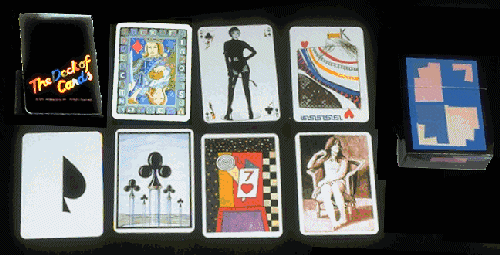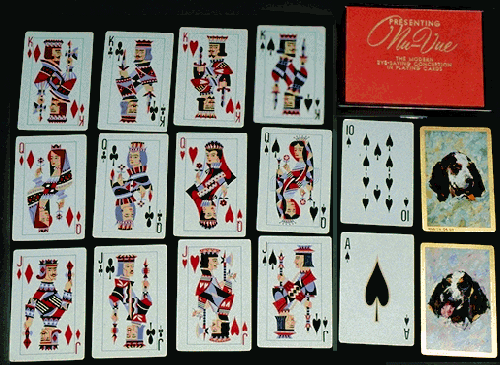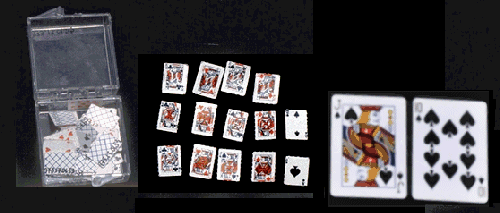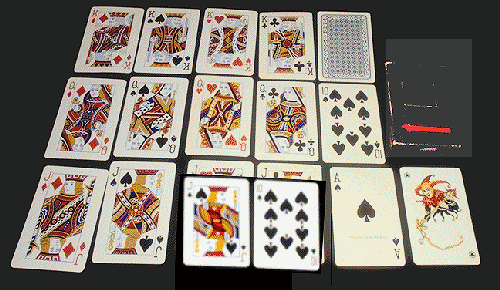What constitute a novelty? Any game equipment that varies considerably from the "standard" or "usual" equipment for that game, might be considered a novelty. In the matter of playing cards, it can be deck size, materials from which the deck is constructed, or perhaps an the optical design of a mass produced deck that is somewhat unconventional compared with the other decks used in a geographic region.
Many artists have used playing cards as the subject of paintings. Some examples can be seen on other pages of this Website. However, a deck of playing cards is in itself the work of an artist. Every card in a deck has to be individually designed by an artist. Each early deck of cards was indeed an individual work of art! Before the era of the printing press, all decks were handmade by artists who first may have painted each card seperately, and then used a wood-block process, and then later, a lithographic process to produce each deck.
In some ways playing card art has been influenced by art styles of the times and places where they were produced. Face cards of early decks (pre 16th century) were miniature portraits of real people, or artistic renderings of imagined historic, literary, and biblical characters. Artists experimented with the number of cards in a deck as well as the suit indicators and where these indicators were placed on a card. Suit indicators had to be designed and reproduced on each card in a deck - and indicators varied depending upon the artist. Face cards became quite stylized. In the 18th and early 19th centuries artistic fancy took flight - decks were designed using an engraving process, and face cards featured intricate comic-strip like drawings satirizing various historic personages and events. By the 19th century, artists designed cards picturing average "citizens" at work and play in traditional costumes. With the advent of the printing press "standard" decks of playing cards began to appear, and a card manufacturer - rather than an artist - decided how a deck would look. For example, while an artist may have designed a deck in multi-colors, French card manufactures decided on the "red-black" standard. Though an artist may have varied the suit indicators somewhat in Italy, card manufactures there decided on the "Latin" symbol standard.
Today, even with modern reproduction techniques, an artist is still required to design and prepare a master card for each card that is to become part of a mass produced deck. Variation in suit indicator shapes, card colors, and face card content may no longer seem to be an issue, but artists continue to experiment and offer new designs for playing card decks - here are some novel examples.
 Each of the cards in the photograph on the left is different, but they are from the same deck.
Each of the cards in the photograph on the left is different, but they are from the same deck.
Each card has a full color or black and white original work of art executed by one of 56 British artists. While one might "play" with these cards, they really were designed for sale as a novelty.
The face of the cards are glossy. Cards have rounded corners. While the international suit indicators are used, on some cards these indicators and numbers are "disguised. Donated to the collection in 1983, the deck partially pictured on the left includes 52 cards and 2 jokers. Each card is 8.8cm long x 6.5cm wide. The backs of the cards are pictured on the box bottom (right side of photograph). The box lid (pictured on the left side of the photograph) features the name of the deck - The Deck of Cards.
Within the box is a pamphlet listing the artists and information about the card they designed. The deck was made by Andrew Jones Art, London, England, in 1979.
 No, the photograph of the deck pictured on the left is not out of proportion - the cards have been designed by the artist to have an elongated and narrow look!
No, the photograph of the deck pictured on the left is not out of proportion - the cards have been designed by the artist to have an elongated and narrow look!
The deck, donated to the collection in 1975, was created about 1970, and produced by Brown and Bigelow in St. Paul, Minnesota (US). The artist is not identified The box is made of black plastic, and the lid (10.2cm long x 13cm wide x 1.2cm thick) is covered with red flocking. The bottom is divided into two sections to hold two decks of cards. The backs of each deck features the head of a Spaniel puppy (pictured on the right). One deck is green, the other blue.
Each deck is composed of 52 cards (8.9cm long x 5.7cm wide) and 2 jokers. Although the deck uses the standard French national suit symbols, all letters and numbers and suit symbols are elongated and narrow. The face cards are "non-standard" and are new designs. Perhaps that is why the deck is titled NU-VUE Playing Cards.

On the left side of the above photograph is a clear plastic hinged box (2.8cm square x 1.5cm thick) which holds a miniture deck of standard playing cards. The cards it holds are a complete set of 52 standard playing cards with international suit symbols. The deck was donated to the collection in 1973.
While "standard" 52 card decks which use the international symbol pattern for playing games like poker or rummy are usually about 8.9cm long x 6.3cm wide, this deck is novel. Each card is 1.5cm long x 1.1cm wide. The backs of the cards have a blue diagonal design on white. The front of the cards consist of the four international suit patterns. No information is available on the manufacturer. (The ink printed numbers that can be seen on the backs of the cards have been placed there so that if one or more of the cards get "separated" from the deck, they can be put back where they belong!)
In order to appreciate the size of this deck, we have superimposed 2 standard sized playing cards on the right side of the picture. Standard cards measure 8.9cm long x 6.3cm wide. Such miniture decks are usually not used to play card games, but may be added to general miniture collections or playing card collections.

The deck partially pictured above was donated to the collection in 1970. It was made by Ferd Piatnik and Sons, Vienna, Austria. The deck comes in a box 18cm long x 12.7cm wide x 2.5cm thick (right side of photograph). The lid of the box is blue with a white interior, and a gold foil label and red arrow. The box bottom is colored the same as the lid, but has a length of white ribbon (16cm) attached to the inside - to help "lift" the deck from the box. A sample card (queen of diamonds) is glued to the back of the box bottom.
The cards are a "standard" 52 card deck with 2 jokers. One joker is pictured on the bottom left of the photograph. The cards feature the international symbol suit indicators. Each card is 17.8cm long x 11.7cm wide. In order to appreciate how large this deck is, we have superimposed the same two standard playing cards (as in the photograph above) at the bottom-center of this picture on top of two of the cards. This deck might be used for playing out-of-doors, on a beach, on a grassy surface, etc.

The purpose of a magnetic deck is to enable people to play a game of cards outdoors on a windy day - or to enable people who can't hold cards to participate in a game with others.
This partially pictured deck was purchased in 1972. Furnished with the deck are a number of plastic platforms with imbedded magnets. Each card in the deck is made of a metallic substance covered with plastic. When one or more cards are placed against one of the platforms with the imbedded magnets, the cards adhere to the platform.
There are 52 standard cards in the deck with 2 jokers. One joker (with lightning bolts) is pictured at the top of the third row. Cards are 8.5cm long x 5.4cm wide and because they are metallic, they are much heavier than ordinary cardboard playing cards.
Pictured on the right of the photograph is a lidded box (9.2cm long x 6.1cm wide x 1.8cm thick) which holds the cards. Card backs are pictured below the box. The cards use the international suit patterns. The deck was made by Magnetic Cards of California, Santa Monica. (If you arrived here from the Magnetic Chess Page, Click Here to return to the Magnetic Chess Page.)
NOTE: This page was originally created and posted on the Web on March 27, 1995. Subsequently it has been modified and periodically updated. Last update: June 13, 2010